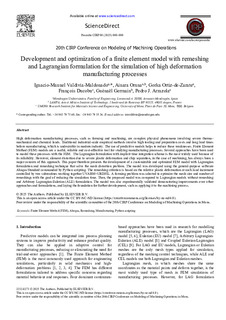| dc.rights.license | Attribution-NonCommercial-NoDerivatives 4.0 International | * |
| dc.contributor.author | Valdivia Maldonado, Ignacio Manuel | |
| dc.contributor.author | Oruna, Ainara | |
| dc.contributor.author | Ortiz-de-Zarate, Gorka | |
| dc.contributor.author | Ducobu, François | |
| dc.contributor.author | Germain, Guénaël | |
| dc.contributor.author | ARRAZOLA, PEDRO JOSE | |
| dc.date.accessioned | 2025-05-06T09:42:24Z | |
| dc.date.available | 2025-05-06T09:42:24Z | |
| dc.date.issued | 2025 | |
| dc.identifier.issn | 2212-8271 | en |
| dc.identifier.other | https://katalogoa.mondragon.edu/janium-bin/janium_login_opac.pl?find&ficha_no=187541 | en |
| dc.identifier.uri | https://hdl.handle.net/20.500.11984/6988 | |
| dc.description.abstract | High deformation manufacturing processes, such as forming and machining, are complex physical phenomena involving severe thermo-mechanical and chemical loads. Traditional industrial-scale empirical methods involve high tooling and preparation costs and long lead times before manufacturing, which is undesirable in modern industry. The use of predictive models helps to reduce these weaknesses. Finite Element Method (FEM) models are a useful, reliable and cost-effective tool for studying manufacturing processes. Several approaches have been used to model these processes with the FEM. The Lagrangian formulation with implicit time integration scheme is the most widely used because of its reliability. However, element distortion due to severe plastic deformation and chip separation, in the case of machining, has always been a major concern of this approach. This paper therefore presents the development of a customizable and optimized FEM model with Lagrangian formulation and remeshing technique that solve the mesh distortion problem. The model was developed using the general-purpose software Abaqus/Standard commanded by Python scripting. The remeshing criterion is based on the relative plastic deformation at each load increment controlled by two subroutines working together UVARM+URDFIL. A forming problem was selected to optimize the mesh size and number of remeshings with the goal of reducing the simulation time. Then, the proposed model was compared to Lagrangian models without remeshing and Arbitrary Lagrangian-Eulerian (ALE) formulation. The model was also experimentally validated demonstrating improvements over other approaches and formulations, and laying the foundation for further development, such as applying it to the machining process. | en |
| dc.language.iso | eng | en |
| dc.publisher | Elsevier | en |
| dc.rights | © 2025 The Authors | en |
| dc.rights.uri | http://creativecommons.org/licenses/by-nc-nd/4.0/ | * |
| dc.title | Development and optimization of a finite element model with remeshing and Lagrangian formulation for the simulation of high deformation manufacturing processes | en |
| dc.type | http://purl.org/coar/resource_type/c_c94f | |
| dcterms.accessRights | http://purl.org/coar/access_right/c_abf2 | en |
| dcterms.source | Procedia CIRP | en |
| local.contributor.group | Mecanizado de alto rendimiento | es |
| local.description.peerreviewed | true | en |
| local.description.publicationfirstpage | 460 | en |
| local.description.publicationlastpage | 465 | en |
| local.identifier.doi | https://doi.org/10.1016/j.procir.2025.02.079 | en |
| local.contributor.otherinstitution | Arts et Métiers Campus d’Angers, LAMPA | es |
| local.contributor.otherinstitution | https://ror.org/02qnnz951 | es |
| local.source.details | Vol. 133 | en |
| oaire.format.mimetype | application/pdf | en |
| oaire.file | $DSPACE\assetstore | en |
| oaire.resourceType | http://purl.org/coar/resource_type/c_c94f | en |
| oaire.version | http://purl.org/coar/version/c_ab4af688f83e57aa | en |
| dc.unesco.tesauro | http://vocabularies.unesco.org/thesaurus/concept625 | en |
| dc.unesco.clasificacion | http://skos.um.es/unesco6/3313 | en |








